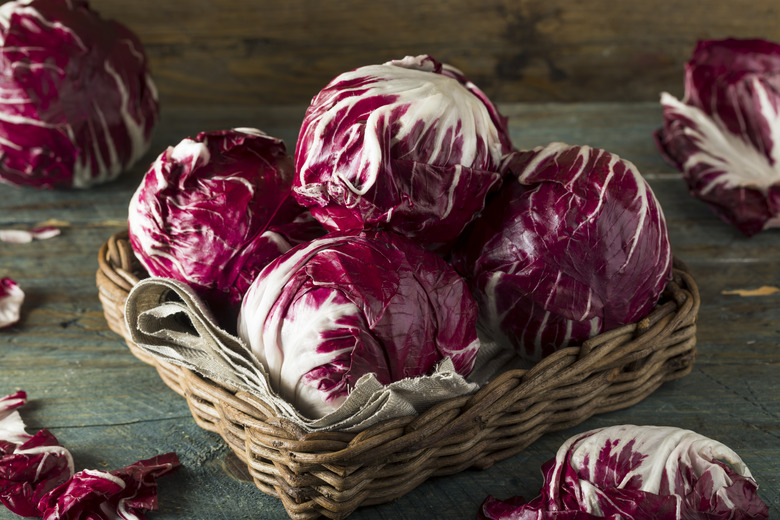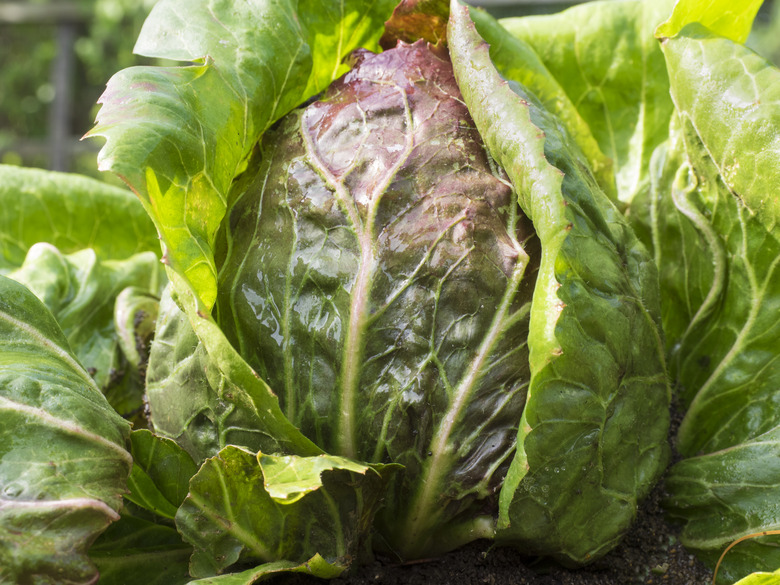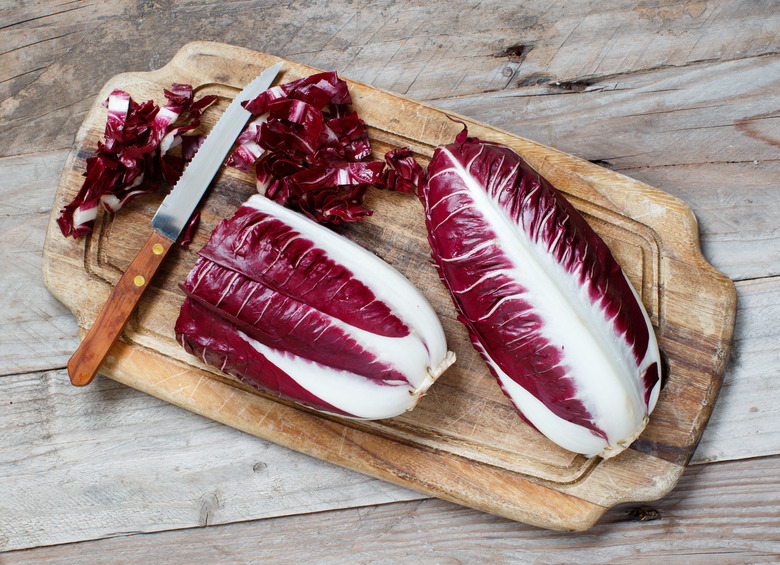How To Grow Radicchio
We may receive a commission on purchases made from links.
Shake up your usual green salad by adding some radicchio (Cichorium intybus var. foliosum) for vibrant color as well as full-bodied taste. Although its leaves have a bitter taste, this flavor provides the perfect foil for the mild taste of other salad greens. Radicchio is actually a type of chicory (Cichorium intybus) called a "heading" form of this plant; that's because the rounded head of leaves is eaten instead of the roots as in "nonheading" varieties.
Radicchio is subdivided into two distinct types: "forcing" types, which require special treatment before plants can form heads, and "nonforcing" types, which don't need any special treatment before plants can form heads. Radicchio plants may form tight or loose heads, and color is dependent on the specific cultivar.
Although chicory plant species grow as biennials or perennials across U.S. Department of Agriculture plant hardiness zones 3 through 8, radicchio is typically grown as an annual vegetable that prospers in cool weather.
What Does Radicchio Taste Like?
What Does Radicchio Taste Like?
Radicchio has a bitter flavor, but it's a versatile vegetable that you can even use as a colorful container for dips or buffet offerings like olives or diced cheese. Simply remove the core from a head of radicchio and fill it with your favorite food. Remove single cupped leaves to hold individual chicken salad servings for your next luncheon.
If the bitter flavor isn't to your liking, salt can help lessen the bitterness. Toss radicchio leaves with salt and olive oil and serve it as a side dish or add it to other greens for a mixed salad. Grill or roast whole heads until the outer leaves are lightly browned or sauté the leaves to add to your favorite stir-fry dish.
Other than its numerous culinary uses, radicchio is so colorful that you can even use it among other ornamental plants in your landscape design until it's time to harvest the heads. It also grows beautifully in containers. Place one head in a mixed planting with other plants as a single colorful accent or grow differently colored radicchio cultivars in a large container vegetable garden, creating a design with the different colors.
How to Grow Radicchio
How to Grow Radicchio
Starting Radicchio From Seed
Direct-seed radicchio in the garden two to three weeks before the last expected frost in early spring or sow seeds in midsummer to harvest a fall crop. You can also start radicchio seeds indoors eight to 12 weeks before the last frost in spring, and the seedlings will be ready for transplanting in the garden two weeks before the last frost.
In the garden, sow radicchio seeds with only a scant 1/4 inch of soil to cover them and keep the soil moist but not waterlogged to improve germination. Seedlings sprout in seven to 14 days. Gradually thin them to a finished spacing of 12 inches apart when they are 3 inches high.
When sowing seeds indoors in trays or pots, make sure the container you use is perforated at the bottom for water to drain. Use a seed-starting mix instead of garden soil and make sure it stays moist but not soggy.
Starting Radicchio From a Seedling
Transplant seedlings in the garden only to the depth they were growing in their containers. If you bury stems deeper than this, the seedlings may rot. Unlike other types of plants, radicchio seedlings can withstand light frosts. If, however, an unexpected hard frost or freeze is expected after you've set out your transplants, protecting them with a floating row cover can help prevent them from being damaged by the cold.
In What Zone Does Radicchio Grow Best?
In What Zone Does Radicchio Grow Best?
Throughout USDA zones 3 to 8, the best zones for growing radicchio are the cooler regions, where plants may have a longer growing season. It can also be successfully grown in warmer climates, where it flourishes during cool weather. During hot weather, it will struggle. Cool-climate gardeners may be able to grow radicchio year-round, but warm-climate growers should expect to grow this vegetable as an annual crop.
When Should You Plant Radicchio?
When Should You Plant Radicchio?
The best times to plant and grow radicchio are during the cool weather of spring and fall. A better guideline may be when not to plant radicchio. In cold climates, gardeners can set out transplants in midsummer around the Fourth of July for a fall/winter crop. However, in warm climates, this time of year is too hot for healthy growth. Plants respond better in these regions when transplanted in early fall around Labor Day.
Soil, Sunlight, and Water Recommendations
Soil, Sunlight, and Water Recommendations
Because radicchio has shallow roots, the top few inches of soil are important to its growth. Although plants prosper in different types of soil, they grow best when the soil pH is between 5.0 and 6.8. The soil must also meet two important criteria: staying moist and draining freely. Soil moisture can be improved by applying a 2-inch layer of mulch around plants, being careful not to pile mulch over the crowns.
For optimal growth, plant radicchio in a location that receives full sun. If you live in a warm climate and you're trying to extend the growing season beyond cool weather to warm weather, planting radicchio where it receives a little shade from the afternoon sun is OK.
Water transplants often until their root systems become established. Thereafter, give plants 1 to 1.5 inches of water each week in the absence of enough rainfall. Irrigating plants with this amount of water can also help lessen the bitterness of radicchio leaves.
Radicchio doesn't have a high need for fertilization; in fact, seedlings may be susceptible to a fungal disease if you give them too much nitrogen from fertilizer. Mature plants that receive too much fertilizer may prematurely bolt, or produce seed stalks, increasing the bitterness of the leaves. Plants respond best when they are given water-soluble fertilizer diluted to half strength and applied according to label directions. An organic option is using a fish fertilizer, specifically fish emulsion, also diluted to half strength.
How to Propagate Radicchio
How to Propagate Radicchio
If you grow heirloom radicchio plants, such as Red Verona, Treviso and Castelfranco, you can save the seeds for sowing the following season. Let some of your plants send up a flowering seed stalk and remove the flower heads when they're dry, typically about two weeks after they've bloomed. The seeds will be attached to white fluffy chaff, which you'll separate from the seeds. Store the seeds in a paper bag or paper envelope in a cool, dry place until you're ready to sow them during the next growing season.
How to Winterize Radicchio
How to Winterize Radicchio
Depending on the climate and cultivar, you may be able to keep fall-planted radicchio plants growing through the winter by covering the plants with a layer of straw or other organic mulch before cold weather sets in. Harvest the heads a couple of weeks before the first frost in fall and cover the crowns with several inches of mulch. Rake the mulch away from the crowns in early spring and the overwintered roots may produce new heads for a spring harvest. This procedure is also one of the ways to grow "forcing" types of radicchio.
How to Harvest Radicchio
How to Harvest Radicchio
If you just want to harvest a few leaves here and there, you can do so at any time by simply peeling each leaf away from the head and cutting it. You can also snap off or pinch individual leaves to remove them but be careful that you don't pull the entire plant out of the ground if you harvest this way.
If you want to harvest entire heads, cut them when they're firm to the touch at any stage of their growth. The older a plant is, however, the more bitter the leaves. Cut the entire plant just below the head at the soil level.
Check the seed package (if you started from seed) or the transplant tag (if you bought transplants) to find the number of days to maturity, which generally is around 60 days. After radicchio matures, the head doesn't get any bigger. Instead, the plant starts forming a flowering stem in its core, which also means that the naturally bitter leaves become even more bitter.
In cold climates, gardeners can harvest radicchio heads even when they are covered with snow. Slowly thaw the heads in the refrigerator and remove the outer leaves, which will be damaged by the cold, to reveal the still-edible leaves. After you harvest radicchio heads, place them in a perforated bag or mesh bag in the refrigerator, where they'll stay fresh up to four weeks.
Common Pests and Other Problems
Common Pests and Other Problems
Some pests may be troublesome to radicchio, particularly during warm or damp weather. Remove aphids, which may be green, red or black, by dislodging them with a stream of water from a water wand or spray bottle. Except in severe infestations, aphids may not cause significant cosmetic damage to the leaves, but they can spread diseases among plants when they pierce the plant tissues to feed on the cell sap.
Slugs, which typically feed at night, leave telltale signs of their presence by chewing large holes in the leaves and creating slime trails across your plants. Place some beer in a cup with straight sides and sink the cup into the ground for easy access by slugs. Slugs will fall into the beer and will be unable to climb out.
Common Diseases of Radicchio
Common Diseases of Radicchio
Damping off is a common disease problem when starting radicchio plants from seed. This collective term covers the same problem that's caused by different fungal pathogens with the word "damp" as a hint to the source of the disease. When you keep seedlings on a substrate that's too damp, they may quickly wilt and die after experiencing healthy-looking new growth. Prevention is the solution to damping off; keep the substrate moist but not wet and avoid overfertilizing plants, particularly with excessive nitrogen.
Some bacterial pathogens cause leaf spot diseases and plant rot. One key to preventing bacterial diseases is to avoid overhead irrigation, such as from a sprinkler system. Hand-water plants with a water wand or the end of your garden hose and direct the water to the base of the plants instead of splashing them and wetting their foliage. Take care to keep plants properly spaced so that air freely circulates around the radicchio heads to help dry the leaves, which prevents moisture-loving pathogens from breeding.


